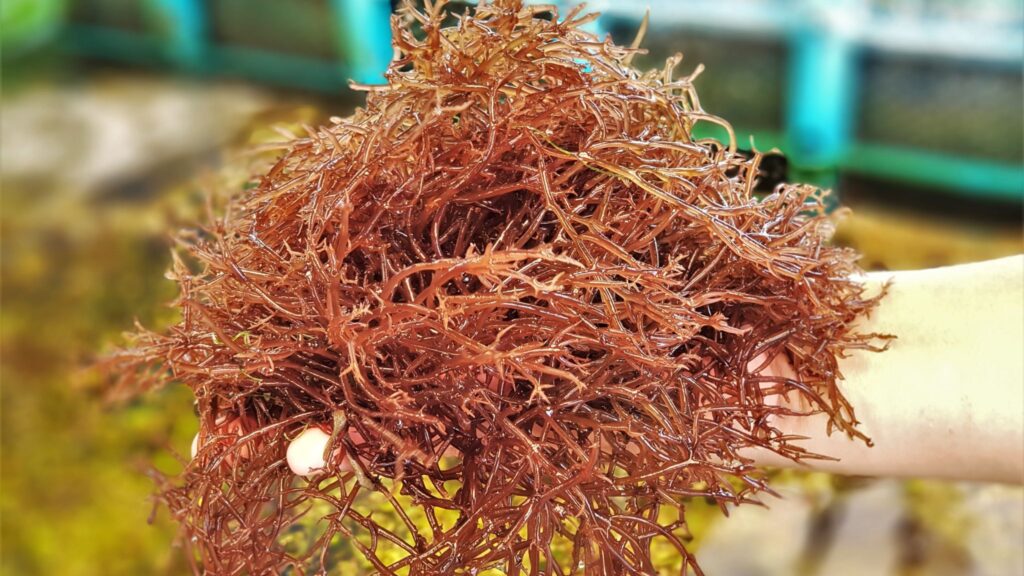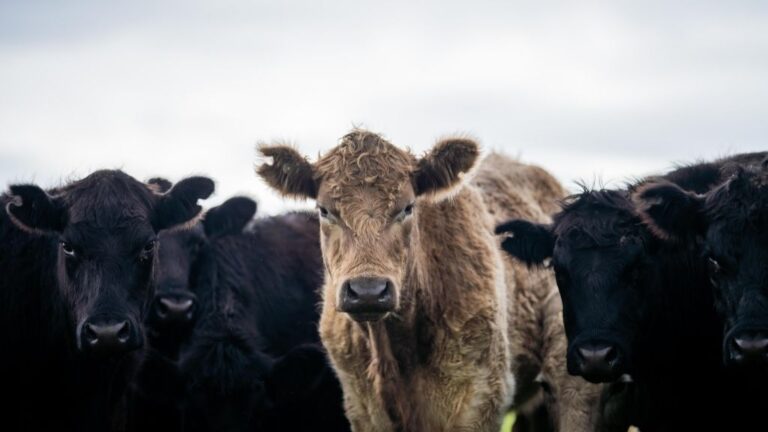An algae-based diet was important for early human evolution and the nutrients they contain are critical for our flourishing. Yet algae play a marginal role in modern Western diets. There is major potential for these incredible organisms to contribute towards a healthier, more sustainable, and more equitable global food system.
In a recent article, I explored the health benefits of including more algae in our diets. This follow-up considers the environmental advantages and socio-economic factors involved in algae production and consumption.

Algae aquaculture can support climate change mitigation and adaptation
Algae-based products have a low carbon footprint. Whether cultivated or harvested from wild sources, algae aquaculture results in fewer carbon emissions than terrestrial agriculture. Algae farming for food and feed (as well as other uses) can also release carbon into the deep ocean, serving as a sink.
These positive impacts on climate change mitigation are complemented by mechanisms for adaptation to a changing climate. For example, naturally growing kelp forests off the coast of Norway have been shown to reduce wave heights by up to 60%. Subsequent research has found that seaweed farms can also buffer and thereby reduce wave energy to protect vulnerable shorelines. Seaweeds thus serve as remarkable ecosystem engineers in this and other ways.
For example, seaweed stands increase the pH in surrounding waters, reducing acidification. Calcifiers are at particular risk from this effect of warming ocean temperatures. Calcifiers are a wide-ranging group of organisms that includes snails, shellfish, and crustaceans such as crabs, lobsters, oysters, and mussels. They play important roles as food for larger organisms and by regulating biochemical processes, including carbon cycling. Their survival thus has critical knock-on effects for marine ecosystems.
On other sustainability measures, algae are also beneficial
The shelter that seaweed farms provide creates habitat for a variety of fish and other marine organisms, supporting high levels of biodiversity. There’s potential for intensive fish farming and other aquaculture activities to be combined with seaweed cultivation, providing nursery grounds for juvenile fish, crustaceans and bivalves. In the long-term, if algae became a more mainstream source of poly-unsaturated fats in Western diets, their consumption could potentially offset pressure on declining fish stocks.
Compared to terrestrial agriculture, algae aquaculture requires far fewer inputs. For example, there’s no need for feed or fertiliser. Land use is greatly reduced. Most algae are produced in marine environments; some can also be grown in fresh water. On land they can be cultivated in marginal areas, such as deserts.
Seaweed farms can also increase oxygen levels in surrounding waters, reducing eutrophication. Large-scale seaweed aquaculture has been found to inhibit harmful algae blooms: algae combating algae!
These organisms can provide beneficial inputs to terrestrial agriculture
Algae cultivation shows considerable promise for reducing pollution in waterways by absorbing toxins. These products may not be viable as a food for humans or livestock especially due to their accumulation of heavy metals. However, they could serve as important inputs to more sustainable terrestrial agriculture. For example, when used as a fertiliser, seaweed biochar or compost can improve soil health for crop production and reduce the need for synthetic fertilisers.
Seaweed can be used as a feed supplement for livestock. Beef cattle whose diet included a red seaweed supplement showed reduced methane emissions of as much as 80%. Looking ahead, the burgeoning insect protein industry is exploring the use of algae as a feed input. Meanwhile, algae fed with insect waste could grow faster, too. And cultured meat can potentially be fed with cyanobacteria or algae instead of crops. This is expected to reduce the carbon footprint associated with the production of both foods.
Algae can be used as a fuel (ethanol or biogas), replacing fossil fuels on farms (and beyond). At the other end of the food chain, algae can contribute to a more sustainable food system both to break down polymer-based plastic packaging and as a biodegradable replacement for less sustainable plastics.
What are the downsides?
The advantages to increasing algae production and consumption seem overwhelmingly positive. But I would be remiss if I made it sound like it was all plain sailing when it comes to the environmental benefits of algae production. Our experiences with other forms of food production provide plenty of evidence and cautionary tales.
Seaweed cultivation is subject to some of the same fallibilities as terrestrial monocultures, and in particular, susceptibility to disease. Ensuring sufficient genetic diversity in seaweed stocks is crucial to avoiding or at least reducing the problems we’ve experienced with our cereal grains, for example.
Monocultures also pose ecosystem risks to biodiversity by potentially crowding out other marine organisms. For example, seaweed (macroalgae) stands can outcompete phytoplankton (microalgae) populations, which are the basis of the food chain for many marine animals.
Non-native seaweed introductions for cultivation can lead to the transfer of pests and pathogens to wild populations. They can also be problematic for reef-building corals, directly competing with and smothering these communities.
Algae farms are often sited near shorelines where they are more accessible. But aquaculture can compete with other activities in these areas, such as fishing and tourism. When seaweed farms are built over seagrass meadows, studies have shown a decrease in fish and invertebrate numbers in these ecosystems, with knock-on effects for local communities that rely on these areas as fishing grounds.
The market for algae has grown significantly, but is concentrated in Asian countries
Despite these challenges, seaweed and microalgae are an environmentally friendly and nutritious opportunity for our food systems.
Over the last 70 years, the volume of algae produced worldwide has increased more than 60 times: from 0.56 million tonnes in 1950 to nearly 36 million tonnes in 2019. The algae industry doubled in size from 2005 to 2015. In 2018, global seaweed production accounted for around 28% of the total volume from aquaculture. And most of the algae harvested is for food for human consumption.
This may seem quite promising—and in many ways, it is—but the vast majority of world production is in Asia (97.4%), with China responsible for more than half of the total volume, followed by Indonesia, South Korea and the Philippines. Europe and the Americas together contributed only slightly more than 2% of world seaweed production in 2019.
Algae could play a much bigger role in our food systems
Seaweed accounted for only 5.4% of the total global value of aquaculture in 2019. The global value of algae aquaculture in 2020 was USD 16.5 billion, in a context where animal aquaculture was valued at USD 264.8 billion and capture fisheries were valued at USD 141 billion.
And while oceans cover more than 70% of the Earth’s surface, they contribute only 2% of the world’s calories. Algae thus represent a very tiny part of our food systems.
In low-income countries, algae production can be an alternative to other livelihoods, including unsustainable fishing methods or where access to other options is more limited. Although algae farming has been found to mostly supplement rather than replace fishing altogether.
That means there is significant potential for these organisms to play a bigger direct role in our diets and serve as a larger source of feed and other inputs to terrestrial agriculture, with all the associated health and environmental benefits that could confer.
Industry has taken notice. A 2020 Seaweed Manifesto sets out a vision for seaweed to play a greater role in contributing to the UN sustainable development goals through increased scale of production focused on responsible and restorative practices.
Governments are getting on board, too. The US passed the 2018 Algae Agriculture Act which considers algae production on equal terms with terrestrial agriculture. In 2022, the European Commission adopted a communication consisting of 23 actions to support the algae sector in the EU. This includes efforts to support business expansion in the sector, develop standards for food safety, and undertake research to fill knowledge gaps. Still, public sector support for the development of the algae sector is nascent or altogether lacking in most countries.
Will we have an algae revolution?
Seaweeds and microalgae could become an important part of more sustainable and healthy food systems beyond Asia. Although there are challenges to achieving production scale, these are not insurmountable, as experience in China and Indonesia demonstrate. Perhaps the biggest constraint is consumer familiarity and acceptance of algae as delicious, nutritious, and environmentally beneficial foods. Changing consumer perceptions could go a long way towards an algae revolution for our food systems.
I write about the future of food and the connections between our food systems, the environment and public health. Sign up for my newsletter.
You can also read more here.






